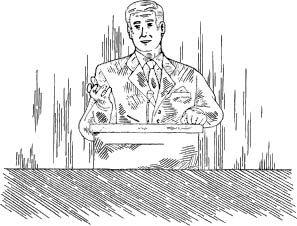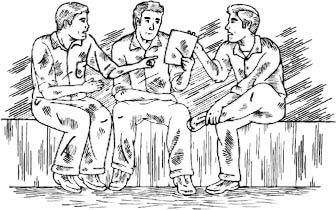The Art of Manliness: Classic Skills and Manners for the Modern Man (31 page)
Read The Art of Manliness: Classic Skills and Manners for the Modern Man Online
Authors: Brett Mckay,Kate Mckay
Tags: #Etiquette, #Humor, #Psychology, #Reference, #Men's Studies, #Men, #Men - Identity, #Gender Studies, #Sex Role, #Masculinity, #Personal & Practical Guides, #Array, #General, #Identity, #Social Science

Figure 7.3 If used effectively, hand gestures can give added emphasis to your words. Don’t worry too much about hand gestures; just let them flow naturally.

Overcoming the Fear of Public Speaking
Speaking in public is one of the most common phobias because people are afraid of looking stupid and embarrassing themselves in front of a large audience. Here are two things you can do to help overcome your fear of public speaking.
Take advantage of any opportunity to speak in front of people. The best way to conquer a fear is to confront it head-on. Find any opportunities available to speak in front of others, even if that means giving the announcements at an office meeting or reading aloud a passage in class. These small steps will help get you ready to stand at the orator’s podium.
Realize your audience doesn’t usually notice your mistakes. Even if they do catch a slipup, they probably won’t care. Audiences are a sympathetic bunch. They understand how nerve-racking it can be to speak in public. Just keep speaking until tomatoes are thrown or you feel a cane around your neck.
Manly Advice: Ten Great Speeches to Study
If a man wishes to become a great orator, he must first become a student of the great orators who have come before him. He must immerse himself in their speeches, reading and listening for the turns of phrases and textual symmetries, the pauses and crescendos, the metaphors and melodies that have enabled the greatest speeches to stand the test of time. Here are ten speeches every man should familiarize himself with.
1. Winston Churchill, “We Shall Fight on the Beaches,” June 4, 1940
2. Demosthenes, “The Third Philippic,” 342 b.c.
3. John F. Kennedy, “Inauguration Address,” January 20, 1961
4. Pericles, “Funeral Oration,” 431 b.c.
5. Frederick Douglass, “What to the Slave is the Fourth of July?” July 5, 1852
6. General Douglas MacArthur, “Duty, Honor, Country,” May 12, 1962
7. Theodore Roosevelt, “Citizenship in a Republic,” April 23, 1910
8. Franklin Delano Roosevelt, “Pearl Harbor Address to the Nation,” December 8, 1941
9. Martin Luther King Jr., “I Have a Dream,” August 28, 1963
10. Abraham Lincoln, “The Gettysburg Address,” November 19, 1863
Give and Accept Criticism Without Coming off Like a Cad
“Nearly all men can stand adversity, but if you want to test a man’s character, give him power.”
—Abraham Lincoln
It’s not the most pleasant part of the job, but every leader must be adept at both taking and receiving criticism. Receiving criticism helps us improve, for it is other people who can point out the mistakes and shortcomings that we can’t see ourselves. And dispensing constructive criticism increases your team or organization’s chances for success. Unfortunately many young men today don’t know how to offer and accept criticism like a man. Instead they handle criticism like little boys. When giving criticism, they opt only to give snide, cutting jabs that do nothing to improve the situation. When receiving criticism, they sulk, make excuses and argue with the person criticizing them.
Because we all face situations every day that require us to give or take criticism, we provide the following guidelines on how to make the process more constructive.
How to Give Effective Criticism
Go in cool, calm and collected.
Before you begin to give criticism, make sure you have your emotions in check. This is particularly important if the person did something that really ticked you off. If you go in yelling and banging your fist on desks, you’ll probably get the problem fixed in the short term. However, you miss out on an opportunity to solve the underlying issues.
Start with the positives.
Before criticizing someone, it’s always good to point out the things that they’ve been doing well. Then transition into your criticism by saying something like, “There is just one area I thought could use improvement…” Two benefits exist from this exercise. First, it will make the criticism easier to swallow by reminding the person they’re not a complete screw-up. Second, it shows the person what they’re doing right and gives them a reference point on which to base future work.
Figure 7.4 Before criticizing someone, it’s always good to point out the things that they’ve been doing well. Then transition into your criticism.

Be specific.
If there’s one thing you remember, let it be this: Be as specific as you can in your critiques. Don’t just tell the person, “This sucks,” or “This could be better.” Explain exactly why their work or action is subpar. A blanket criticism will put the person on the defensive, and they’ll never be able to correct their problem.
Criticize the action, not the person.
Avoid making your criticism personal, and focus only on the person’s actions instead. This makes the criticism less hurtful and much more effective. So don’t say things like, “Jeez Louise you must be an idiot! Look at all these mistakes you made in this report!” Just because someone makes a mistake doesn’t mean that person is a pinhead. We all have bad days.
Be a diplomat.
When giving your specific criticism, it sometimes helps to use diplomatic words. Our old friend Benjamin Franklin was a master at this (which is why he was probably such a successful diplomat). In his autobiography, Franklin said this about using diplomatic language in discussion:
“When I advance anything that may possibly be disputed, [I never use] the words certainly, undoubtedly, or any others that give the air of positiveness to an opinion; but rather say, I conceive or apprehend a thing to be so and so; it appears to me, or I should think it so or so, for such and such reasons; or I imagine it to be so; or it is so, if I am not mistaken.”
Using such diplomatic words removes the sharp edge from your criticism. Sometimes, however, people need that edge to spur them to action. Use your discretion in deciding whether a harsher approach would be more appropriate.
Make specific suggestions for improvement.
The goal of criticism should be to help someone make improvements. While specifically pointing out the problem is the first step to correction, if a person doesn’t know what they can do to improve, knowing their mistakes won’t help them one bit. Don’t just tell people what’s wrong with their work, give them specific suggestions on how they can improve it. The key word, once again, is
specific
.
Follow up.
Always, always follow up after giving constructive criticism. Your criticism won’t do any good if the person doesn’t put your suggestions into practice. Schedule a follow-up with the person you’ve critiqued. Say something like, “How about we meet together next week to see how your changes are coming and to answer any new questions you might have?” By letting the person know you’ll be following up with them, they’re more likely to get their butt in gear and make the needed corrections.
How to Take Criticism
Consider the source.
You’re going to receive criticism from thousands of people in your lifetime. It’s important to remember that not all criticism is created equal. If you think the source of your criticism isn’t genuinely interested in helping you improve, take their criticism with a grain of salt. At the same time, be sure to honestly assess your critic’s point. Some people are too quick to write off criticism by saying, “They’re just jealous!” Maybe so, but be sure to thoughtfully evaluate the feedback before dismissing it.
Shut your trap and listen.
Fight the urge to argue with the person or explain your mistake, and just open your ears. You’d be surprised what you can learn if you simply soak it in.
Don’t take it personally.
Try to detach yourself as much as possible from your actions or work when receiving criticism so you can look at it objectively. This can be hard to do, particularly if you put a lot of time and effort into something. But trust me, if you make this a habit when receiving criticism, you’ll save yourself from a bruised ego.
Stay calm (even if the other person is being a complete scalawag).
If your critic is being a
well-meaning, pinheaded, anarchistic crank,
staying calm can be hard to do. But be the better man. Let the other person do all their ranting and raving, while you sit there looking cool as a cucumber. When they’re done, kill them with kindness. Let them know you understand their concern and thank them for taking the time to bring it to your attention.
Ask clarifying questions.
Clarifying questions are particularly important if your critic gives vague or ambiguous criticism. For example, if your critic tells you your report isn’t clear, ask them where things start to get murky and suggestions on how it can be improved. By asking questions, you create dialogue between you and your critic, which in turns fosters cooperation and an atmosphere for mutual improvement.
Take ownership of your mistake.
When someone brings a legitimate mistake to your attention, don’t get on the defensive and start making excuses for it. Take responsibility for your actions. While denying your mistakes can keep the heat off for a moment, it will greatly impede your personal progress in the long run.
Change your perspective on criticism.
Instead of seeing criticism as humiliating or embarrassing, view it as an opportunity to improve yourself. Winston Churchill had this to say about criticism:
“Criticism may not be agreeable, but it is necessary. It fulfills the same function as pain in the human body. It calls attention to an unhealthy state of things.”
Instead of avoiding criticism, seek for opportunities to be criticized. You’ll find that getting feedback from an outside source will stretch your talents and abilities.
Thank your critic (even when he handed your butt to you).
This can be difficult. No one seriously wants to say, “Thanks for showing me that I was wrong!” But swallow your pride and sincerely thank your critic. They took the time to sit down with you and point out areas where you can improve. The least you can do is say thanks.
Take action and follow up.
After you’ve received your criticism, take action immediately. After you’ve taken action, make sure to follow up with your critic and let them know how you’ve rectified the problem. This shows that you actually listened to the criticism and respected what the person had to say.
